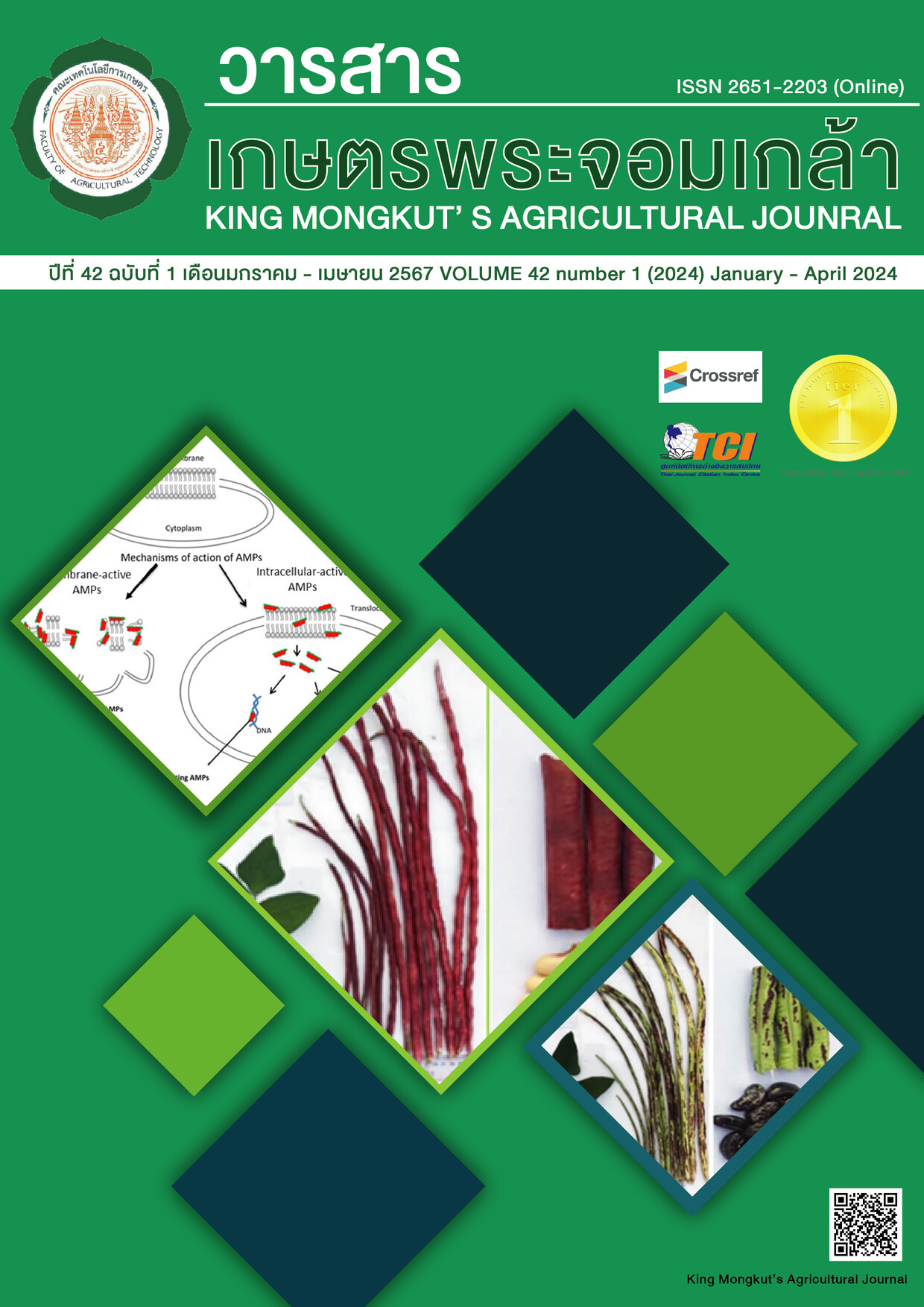การบำบัดน้ำเสียที่มีสีย้อมเบเนฟิก เรด ปนเปื้อนโดยใช้สาหร่ายสีเขียวขนาดเล็ก Nannochloropsis oculata ที่ตรึงในอัลจิเนต
Main Article Content
บทคัดย่อ
การศึกษาสภาวะที่เหมาะสมและจลนพลศาสตร์การดูดซับสีย้อมเบเนฟิก เรด โดยสาหร่ายNannochloropsis oculata ที่ตรึงเซลล์ในอัลจิเนต พบว่าสาหร่ายดูดซับสีย้อมได้ดีที่พีเอช 2 มีการดูดซับสูงที่สุด คือ 0.90±0.01 มิลลิกรัมต่อกรัม ระยะเวลาเข้าสู่สมดุลการดูดซับคือ 2 ชั่วโมง มีค่าการดูดซับ 1.80±0.02 มิลลิกรัมต่อกรัม ปริมาณของสาหร่ายที่เหมาะสมคือ 2 กรัมต่อลิตร โดยดูดซับสีย้อมได้ 3.98±0.02 มิลลิกรัมต่อกรัม โดยปริมาณการดูดซับ (qeq) สีย้อมจะลดลงเมื่อปริมาณสาหร่ายเพิ่มขึ้น ไอโซเทอร์มการดูดซับสีย้อมนั้นสอดคล้องกับสมการของ Langmuir โดยมีค่าการดูดซับสีย้อมสูงสุด (Qmax) เท่ากับ 106.58±20.22 มิลลิกรัมต่อกรัม และการดูดซับสีย้อมเป็นปฏิกิริยาอันดับปฏิกิริยาหนึ่งเสมือน (pseudo first-order) และมีขั้นกำหนดอัตราเร็วในการดูดซับคือการแพร่ผ่านชั้นฟิล์มและการแพร่เข้าภายในเซลล์ขั้นที่สอง จากผลการศึกษาแสดงว่าสาหร่าย N. oculata ที่ตรึงในอัลจิเนตเป็นตัวเลือกที่มีประสิทธิภาพในการนำไปใช้กำจัดสีย้อมเบเนฟิก เรด ที่ปนเปื้อนในน้ำเสียได้
Article Details

อนุญาตภายใต้เงื่อนไข Creative Commons Attribution-NonCommercial-NoDerivatives 4.0 International License.
วารสารเกษตรพระจอมเกล้า
เอกสารอ้างอิง
Akzu, Z., & Tezer, S. (2005). Biosorption of reactive dyes on the green alga Chlorella vulgaris. Process Biochemistry, 40(3-4), 1347-1361. https://doi.org/10.1016/j.procbio.2004.06.007
Aldegs, Y., Elbarghouthi, M., Elsheikh, A., & Walker, G. (2008). Effect of solution pH, ionic strength, and temperature on adsorption behavior of reactive dyes on activated carbon. Dyes and Pigments, 77(1), 16-23. https://doi.org/10.1016/j.dyepig.2007.03.001
Buhani, Suharso, Miftahza, N., Permatasari, D., & Sumadi. (2021a). Improved adsorption capacity of Nannochloropsis sp. through modification with cetyltrimethylammonium bromide on the removal of methyl orange in solution. Adsorption Science & Technology, 2021(9), 1-14. https://doi.org/10.1155/2021/1641074
Buhani, Wijayanti, T. A., Suharso, Sumadi, & Ansori, M. (2021b). Application of modified green algae Nannochloropsis sp. as adsorbent in the simultaneous adsorption of methylene blue and Cu(II) cations in solution. Sustainable Environment Research, 31(1), 1-12. https://doi.org/10.1186/s42834-021-00090-y
Celekil, A., Yavuzatmaca, M., & Bozkurt, H. (2012). Binary adsorption of reactive red 120 and yellow 81 on Spirogyra majuscula. Middle East Journal of Scientific Research, 1(2), 29-36. https://doi.org/10.5829/idosi.mejsr.2013.13.6.2316
Gunasundari, E., Kumar, P. S., Rajamohan, N., & Vellaichamy, P. (2020). Feasibility of naphthol green-B dye adsorption using microalgae: thermodynamic and kinetic analysis. Desalination and Water Treatment, 192(2020), 358-370. https://doi.org/10.5004/dwt.2020.25777
IBM SPSS Statistics. (2023). KMITL SPSS Version29. Retrieved from: https://drive.google.com/file/d/1FDY_FmOy1PgwB3l7ARGBA-6XJy84kcBW/view?usp=sharing.
Kumar, S., Ahluwalia, A. S., & Charaya, M. U. (2019). Adsorption of orange-g dye by the dried powdered biomass of Chlorella vulgaris Beijerinck. Current Science, 116(4), 604-611. https://doi.org/10.18520/cs/v116/i4/604-611
Neag, E. & Roman, C. (2017). Applications of microalgae in wastewater treatment experimental and equilibrium studies. In Proceedings of 2017 International Conference on Hydraulics and Pneumatics – HERVEX, pp.318-324. Institute for Analytical Instrumentation Russian Academy of Sciences.
Ozer, A., Ozer, D., & Eklz, H. I. (2005). The Equilibrium and Kinetic Modelling of the Biosorption of Copper(II) Ions on Cladophora crispata. Adsorption, 10(4), 317-326. https://doi.org/10.1007/s10450-005-4817-y
Radwan, E. K., Abdel-Aty, A. M., El-Wakeel, S. T., & Abdel Ghafar, H. H. (2020). Bioremediation of potentially toxic metal and reactive dye-contaminated water by pristine and modified Chlorella vulgaris. Environmental Science and Pollution Research, 27(17), 21777-21789. https://doi.org/10.1007/s11356-020-08550-5
Ruangsomboon, S., & Chonudomkul, D. (2022). Effect of CO2 concentration on growth, CO2 fixation, and biochemical composition of the microalga Nannochloropsis oculata. Chiang Mai Journal of Science, 49(2), 325-338. https://doi.org/10.12982/CMJS.2022.035
Sani, Z. M., Dalhatu, A. S., Adam, B. S., Mohammed, K., Muhammad, Y. Y., & Ibrahim, S. (2021). Bioremediation of some reactive dyes commonly used in Fabric re-dyeing by Chlorella vulgaris. Asian Journal of Environment & Ecology, 15(4), 10-19.
Sarwa, P., Vijayakumar, R., & Verma, S. K. (2014). Adsorption of acid red 66 dye from aqueous solution by green microalgae Acutodesmus obliquus strain PSV2 isolated from an industrial polluted site. Open Access Library Journal, 1(3), 1-8. https://doi.org/10.4236/oalib.1100712
Schiewer, S., & Volesky, B. (2000). Biosorption Processes for Heavy Metal Removal. In Lovley, D.R. (Ed.) Environmental Microbe-Metal Interactions, pp.329-362. American Society for Microbiology.
Vojnovic, B., Cetina, M., Franjkovic, P., & Sutlovic, A. (2022). Influence of initial pH value on the adsorption of reactive black 5 dye on powdered activated carbon: kinetics, mechanisms, and thermodynamic. Molecules, 27(4), 1-12. https://doi.org/10.3390/molecules27041349
Yemendzhiev, H., Alexieva, Z., & Krastanov, A. (2014). Decolorization of Synthetic Dye Reactive Blue 4 by Mycelial Culture of White - Rot Fungi Trametes Versicolor 1. Biotechnology & Biotechnological Equipment, 23(3), 1337-1339.


